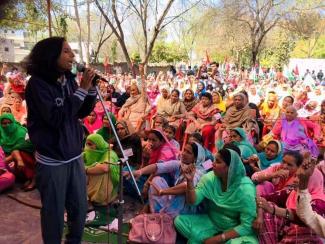
IN the first part of this article we traced the genesis of the movement and discussed its most distinctive demands and slogans. In this concluding part, let us talk about its salient features, key achievements and long term perspective before taking up the question as to how the movement must be carried forward in the changed situation marked by the Delhi pogrom and the Corona pandemic.
Fine Blend of Spontaneity, Creativity and Networking
The People's festival of protests has been impressive not just for the scale of mobilizations, which comprised people from all communities, and on many occasions ran into tens of thousands and even lakhs. Equally noteworthy is the stamina and determination both at individual levels (recall the young mother at Shaheen Bagh whose small child died because of exposure to biting cold night after night, but who continued to participate in the sit- in "for the sake of my country and my people") and as group initiatives (look at the sustained protest at the numerous Shaheen Baghs).
Another strong point of the mass uprising lies in the diverse creative ways individuals and groups have been contributing to it on their own initiatives. For example, the landmark big map of India in the original Shaheen Bagh, set in an iron frame with the words "We the people of India Reject CAA NPR NRC" inscribed on it, was created and erected by a group of artists from different universities with the help of local volunteers. Similarly, the Fatima Sheikh-Savitribai Phule library-cum-reading space was started by one young post- graduate from AMU with some forty books only. Very soon, the collection crossed a thousand books while sitting arrangements were made by enthusiasts who appreciated this endeavour for spreading knowledge as part of the movement. In addition to the Constitution of India – which happens to be the most sought-after book and is available in many copies – titles by Gandhi, Ambedkar, Bhagat Singh, Nehru, Tagore, A K Azad as well as later-day authors like Arundhati Roy, Gauri Lankesh are also available, and so are books by the likes of Hitler and Savarkar. The task of systematically running the library has been taken up by young activists and local people. Visitors from certain other sites were so impressed that they wanted to set up libraries in their own areas. In response, young people including AISA activists in Shaheen Bagh came forward to help spread the People's Library campaign and thereby developed new contacts also.
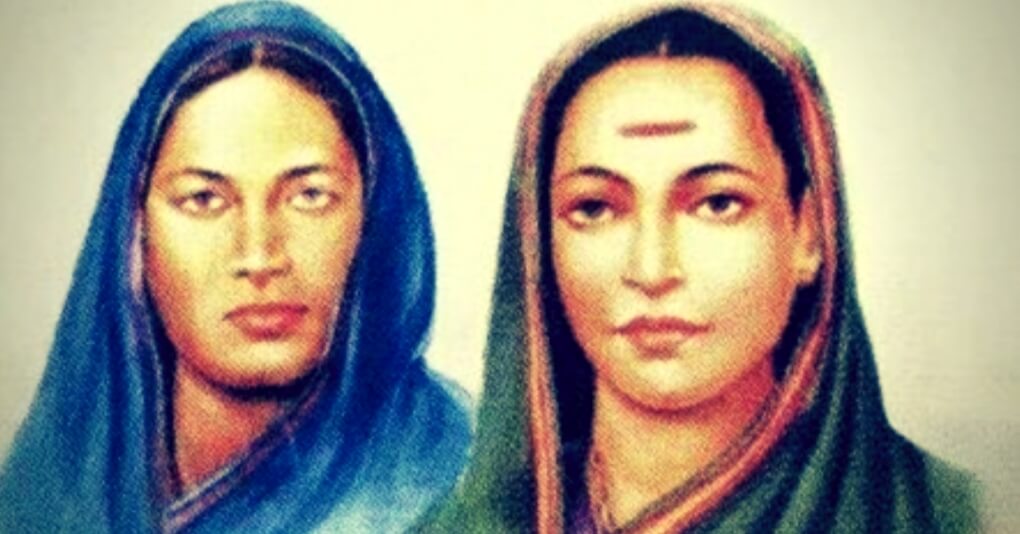
This is how – and there are any number of instances like these – the movement has been sustaining and expanding itself. The absence of any Party banner also facilitates spontaneous and energetic participation of those who, for whatever reasons, tend to avoid partizan programs. Moreover, since everybody is equally entitled to issue a call or initiate and event, any major development – for example the attack on Jamia and JNU or even a threat – prompt the protesters/ supporters of the movement to get actively involved through networking on social media. Thus it was that the seven-day long cultural fest was conceived and launched at the original Shaheen Bagh in early February, within hours after the Hindu Sena threatened a counter mobilization at the protest site.
The all India Movement has no command structure, but certainly has a unity of purpose and a set of common policies. The protesters should, under all circumstances, try and remain peaceful. Even in verbal communications, it should never slip into hate mongering and the 'tu-tu mayn mayn' (aggressive name-calling and brazen boastfulness) that characterize much of political discourse today. The focus of the protest should never shift from the single point agenda of opposition to the CAA-NRC-NPR scheme and allegiance to the Constitution. No political party or leader should be allowed to dominate the autonomous agitation or to use it for narrow partisan interests.
Participants in joint mobilizations without any organisational banners willingly follow these norms. On the other hand, parties/platforms/ organisations hold their independent programs under their own banners and in whatever ways they choose to. But they too try and abide by the general understanding of the broader movement and never fail to express warm solidarity with other wings or components of the movement.
A very broad unity and coordination amidst a rich diversity of initiatives, taken by hitherto unconnected individuals and groups, has thus emerged as a suitable template for the progress of the movement at this stage. It matches the mood of the masses, particularly the young people, provides enthusiasts with ample free space for creative involvement, and facilitates maximum mobilization.

Three Icons or Rallying Points
Three icons, most prominently visible and audible in every protest everywhere, have emerged as symbols of the United resistance of all Indians against the deceptive, discriminatory and deceitful CAA- NPR- NRC matrix. These are: the national flag, the national anthem and the Constitution of India or more precisely, the Preamble to the Constitution.
All three icons are closely associated with – in fact they are product of – our glorious freedom struggle. All three are hundred percent secular and equally inspiring. However, the Preamble is of special importance. It leaves nothing to symbolism or allusion: in direct and concise terms it lays down the key ideals the Republic of India stands for and the basic principles of the supreme law of the land – to which every other law/ rules /regulations/ government policies etc. must conform. Since the CAA-NPR-NRC project as a whole militates against those ideals and principles, protesters assert in every public reading of the Preamble, it must be withdrawn or rejected lock, stock and barrel.
This assertion leads the protesters, and all who hear them, to a novel and profound realization. If we the people of India are the supreme authority of the land, then who are Modi- Shah to question our bona fides as citizens of India? How dare they decide who among us will have to leave the country or end up in detention camps despite already having official documents like Epic and Aadhar cards? This is simply not acceptable. The anti-constitutional CAA - NPR - NRC project must be revoked permanently and in its entirety, not partially or just for the time being. And all the more so because the scheme strikes at the heart of the fundamental principles on which the Republic stands : Justice, Liberty, Equality, and Fraternity. Such is the courage of conviction that lies at the root of the exemplary tenacity of protesters.

The Key Achievements
First and foremost, the movement has compelled the party in power to beat at least a tactical retreat on the citizenship front. The central government now says that 'so far' there has been no decision about NRC. It is also soft pedaling on NPR. Under the impact of the movement, legislative assemblies in many opposition-ruled as well as NDA-ruled States have passed resolutions expressing different degrees of opposition to the contentious project.
Clearly, there is a lot of trickery and duplicity involved here. The unanimous resolution adopted in Bihar Assembly is a case in point. Its highlights are: (a) there is no need for NRC in Bihar at present (which means all options remain open for the future) (b) NPR will be implemented, albeit in the 2010 format (which can very well be used as a basis for NRC) and (c) no opposition to the CAA, since the matter is pending before the Supreme Court. The Bihar resolution – and those in most other state assemblies – should therefore be read as an important but partial victory of the movement, which remains to be carried to its logical culmination, that is, total and unconditional revocation of the entire project.
It is interesting to note that BJP leaders and ranks on the ground are also feeling the heat of the agitation and changing tack. For example, the BJP-dominated Selu Municipal Council in Parbhani district in Maharashtra has unanimously passed a resolution against the implementation of CAA and NRC.
Secondly, it is thanks to the movement that even the most virulent Sanghi propaganda has failed to polarize society to the extent they desired. This is quite evident from the recent election results in Delhi. For all its hateful communal campaigning, the BJP managed to register only a small increase in vote share and seats compared to the 2015 assembly election.
Another precious contribution of the movement has been the emergence of India's largest minority community as an advanced contingent in the struggle to defend democracy and the Constitution against fascist onslaughts. Casting aside the sense of isolation and frustration that was thrust upon then over the decades and particularly during the Modi Regime, Indian Muslims have hit the streets in great numbers, with the Constitution and the national flag in their hands, to fight for a secular cause that concerns all Indians. On the collision course against the powers that be, they have found a reassuring source of strength and confidence in the respect and camaraderie extended by fellow fighters from other communities. The militant unity thus forged, further bolstered by active participation of Dalit contingents, is no doubt a powerful bulwark against the divisive policies of the majoritarian state.
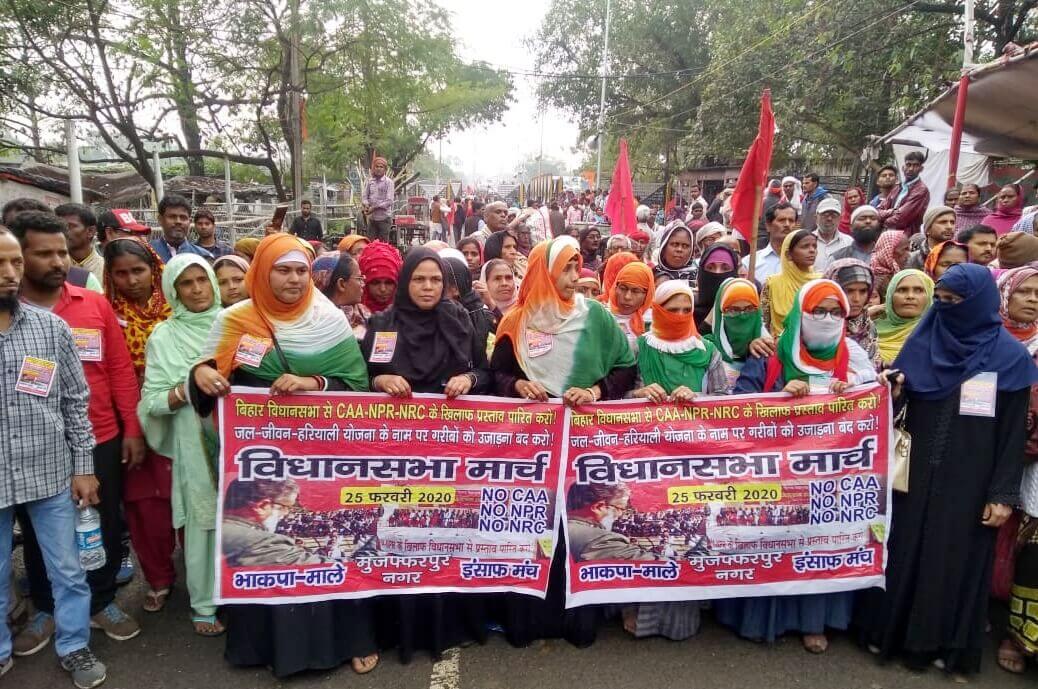
Arguably the most significant part of this democratic awakening is the independent assertion of Muslim women from all backgrounds: illiterate/semi-literate housewives and working women, students and educated women, activists, intellectuals and professionals and so on. The movement has inspired and empowered them to break free from patriarchal and religious restrictions. They are now speaking for themselves and playing leading roles not only in Shaheen Baghs but in rallies and marches too. To be sure, this is a very significant contribution of this agitation to the broader democratic movement and women's movement in our country.
Every historic movement leaves its mark on art and literature, and the present one is no exception. National award winning lyricist Varun Grover's new creation "Hum kagaj nahi dikhaenge" (we will not show our documents) for example expresses the defiant spirit of the agitation with such power and eloquence that it has become a marching song of protesters throughout the country. And then you have the good old "Hum Dekhenge" (we shall come to see), composed by Faiz Ahmad Faiz in 1979 targeting the authoritarian Pak President Zia- Ul Haq, resurfacing with a new connotation and new relevance in the current Indian context. It has been translated into almost all major Indian languages and has acquired the status of a new national song, so to say, a song that accurately captures the people's revolutionary aspirations in the struggle against Indian fascism. Mention must also be made of activist Amir Aziz's spoken word pieces like "Sab kutchh yaad rakhha jayega" (everything will be remembered) and "Yeh hain Jamia ki ladkiyan" (here are the Jamia girls).
In addition to poems and songs, the movement's cultural harvest includes many other art forms like street plays, paintings, stand-up comedies and video clips uploaded on the YouTube. Widely shared on social media, they carry the message of the movement far and wide and serve to inspire and recruit new activists. The explosion in revolutionary democratic art and literature is no doubt a major achievement of the popular movement.
While building on the achievements, we must try and overcome certain weaknesses also. For example, we need to focus more on mobilising non- Muslim working people and democratic forces with persuasive and painstaking campaigning. Special attention must be paid to mobilization of social groups who are vulnerable to RSS-BJP propaganda, such as sections of Bengali Hindu immigrants who had migrated from East Pakistan /Bangladesh during or after Partition and who tends to have a soft corner for CAA.
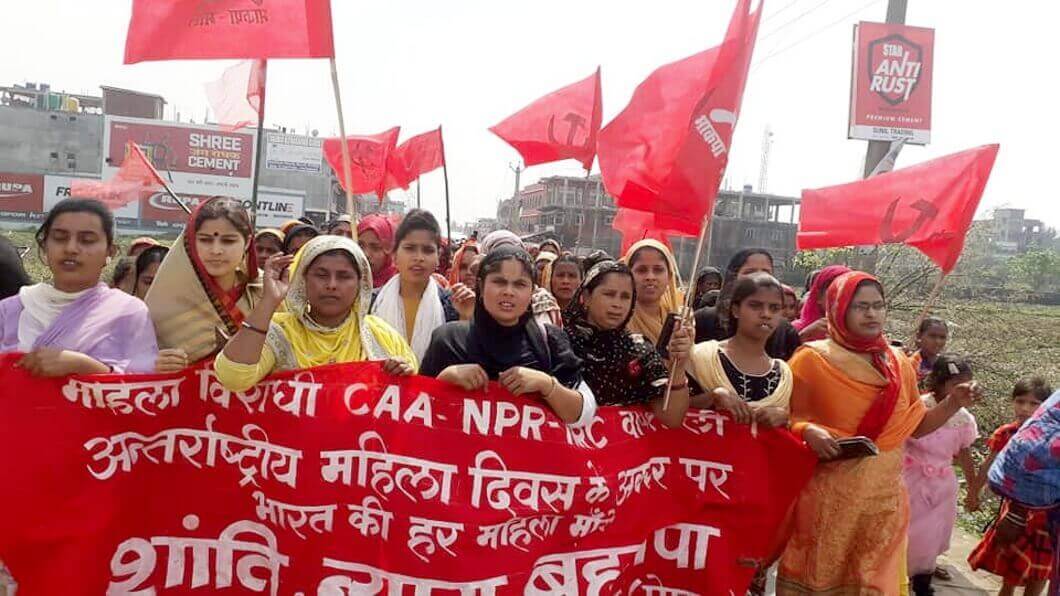
Manuvadi Hindu Rashtra or Secular Democratic Republic?
As we know, right from 1857 the national liberation movement in our country developed on the strength of a robust Hindu Muslim unity. That was the main trend of the times. But there was also an opposite undercurrent of communal animosity, which was cunningly fostered by the British Raj and finally took the shape of two nations theories of Savarkar- Golwalkar on one hand and of M A Jinnah on the other. The first trend - - the united struggle against colonialism – gave us our independence, and the second, the trauma of Partition. But the Partition remained incomplete in that a very large number of Mohammedans chose not to migrate from India, while a large number of Hindus opted for staying back in Pakistan, East Pakistan in the main. The Sanghi dream of constructing a great Hindu homeland and a pure Hindu rashtra as a counterweight against Islamic Pakistan was thus fulfilled only in part. As the Hindutva brigade see it, the project remained incomplete in two respects. First, a large number of Hindus remained trapped as a persecuted lot in the neighbouring Muslim-majority countries and second, a huge number of Muslims, who are as a rule anti-national and pro-Pakistan, lived on in 'our' land as a pampered lot. Now, firmly saddled in power, the Sanghis are trying to solve the first problem with the CAA, which they claim would provide all Hindus, including those who have come from and will come from Muslim majority countries in our neighbourhood, with an easy route to registered citizenship. And to solve the second problem they have plans to press into service the NPR-NRC mechanism, which would render a large chunk of Indian Muslims stateless and liable to be deported or put into detention camps as cheap prison labour. This is how the Sanghi dispensation is trying to bring to consummation the unfinished task of partition based on their two nations theory. This is how they are trying to build a de facto Hindu rashtra in a Hindu homeland through an Indian version of ethnic cleansing.
It is against this whole sinister design that the current agitation is directed. It has already gone a long way in healing the open wounds of partition by bringing Hindus and Muslims together in an all India political struggle. At the core of the struggle lies a choice between two options. The Sangh Parivar is desperate to accomplish its original mission of a Hindu Nation in a majoritarian state, which is by definition Manuvadi, i. e., anti-women, anti-Dalit, anti-Muslim. On the other side of the battle line are these persecuted underdogs of Indian society, out on the streets with other fellow Indians to reclaim the secular democratic republic where everyone will enjoy the same dignity and freedom, rights and opportunities. In fact such a just, free, egalitarian and compassionate society is what our freedom struggle aspired to achieve, but never achieved in full. That unfinished task the protesters are now trying to fulfill, just as the Sangh Parivar with its divisive policies is conspiring to complete the unfinished business of Partition.
With this long term perspective on the movement, we need to think over and decide how best to carry it forward today in keeping with changes in objective situation.
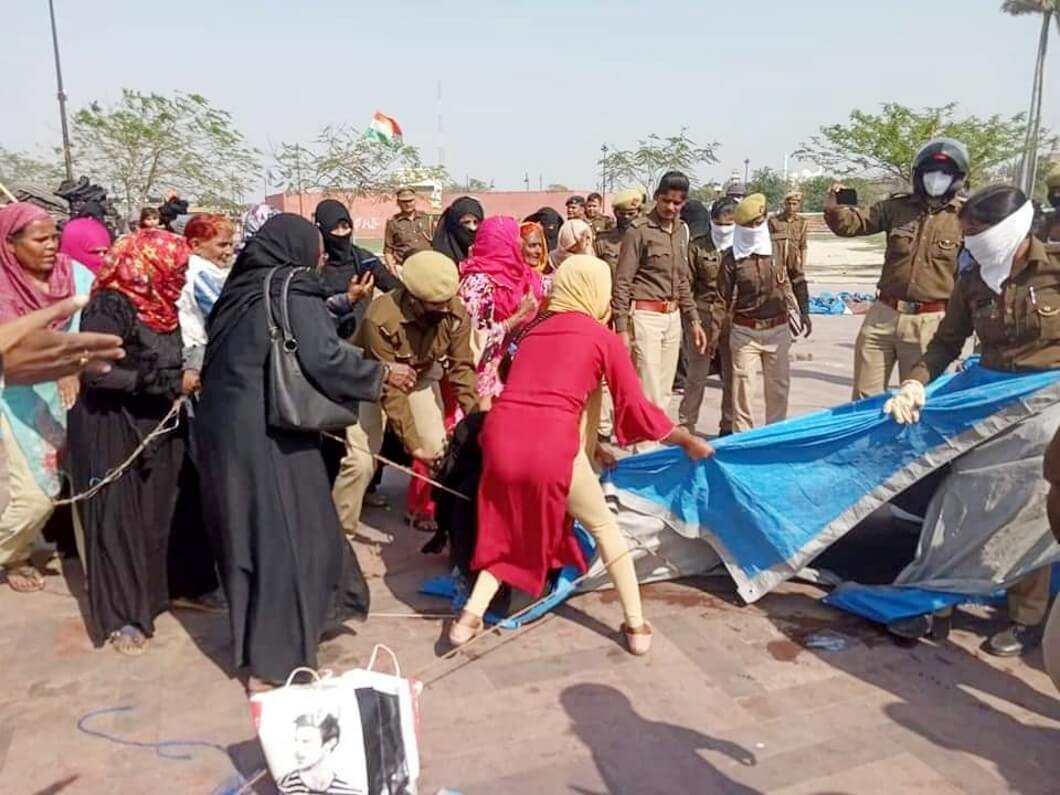
In the Aftermath of Delhi Pogrom and Corona Outbreak
Over the past one month the movement has continued despite virulent hate campaigns, state repression and finally an anti-Muslim pogrom designed to crush it in its citadel. In addition to rallies, sit-in protests, seminars (such as the one in Patna on March 5, which proved highly effective in mobilising and interacting with a wide range of social and political forces) etc., certain new forms of protest have been devised. In Odisha for example, as many as 402 gram sabhas in 15 districts have passed resolutions urging the state government to stop the implementation of CAA and pull out from the NPR exercise. A memorandum was also sent to the Chief Minister and the district collectors of these districts. The move was organised by social organisations like Campaign for Survival with Dignity and Odisha Nari Samaj. Similar initiatives are being taken by us in Bihar and some other states.
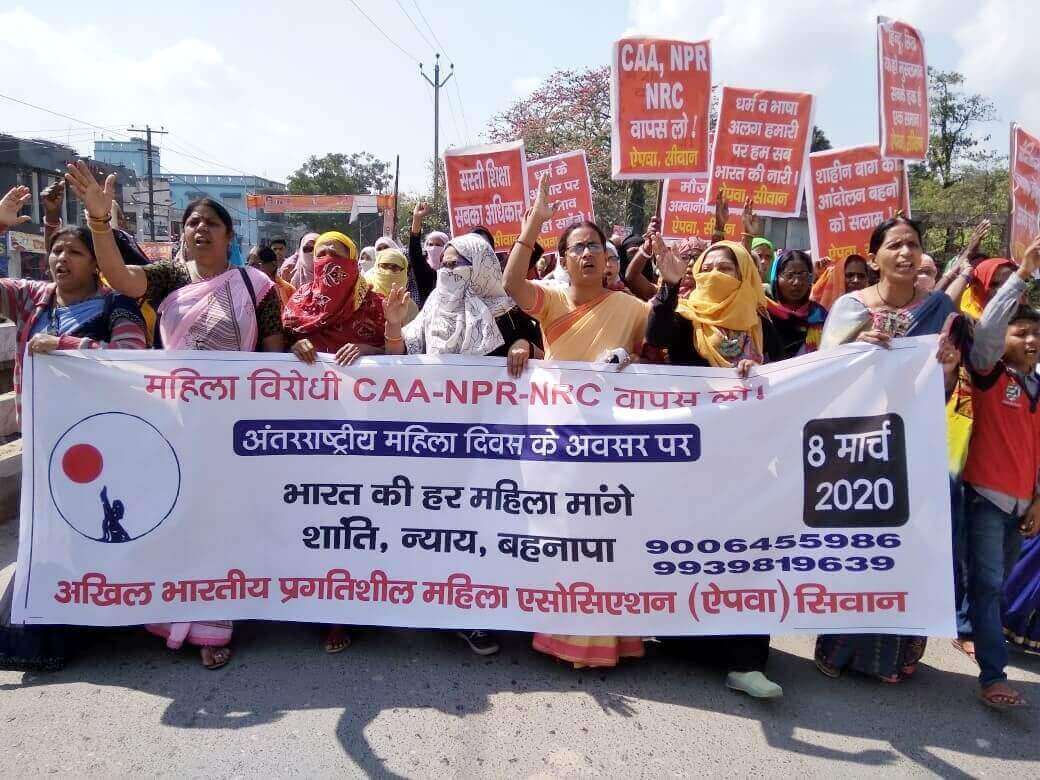
The international Women's Day this year saw women across India coming out on the streets rejecting the CAA-NRC-NPR project. AIPWA and other women’s organisations raised their voice against Sanghi attempts to drown the current protest movement in state-sponsored violence and demanded exemplary punishment for the culprits. In many of these programs rural and urban working women including scheme workers played a very prominent and active role. At Mansa the Sambidhan Bachao Manch (Save the Constitution Forum) organised a massive protest. Addressing the gathering, former JNU president Geeta Kumari said that the women's struggle against the new citizenship laws and rules are also a part of their own struggle for equality, dignity and freedom. The Indian women's struggle also found a strong echo beyond the borders of the country. In London for example, a vibrant contingent of women marched in solidarity with Shaheen Bagh with slogans like " Shaheen Bagh we stand with you, you won't let the fascists through".
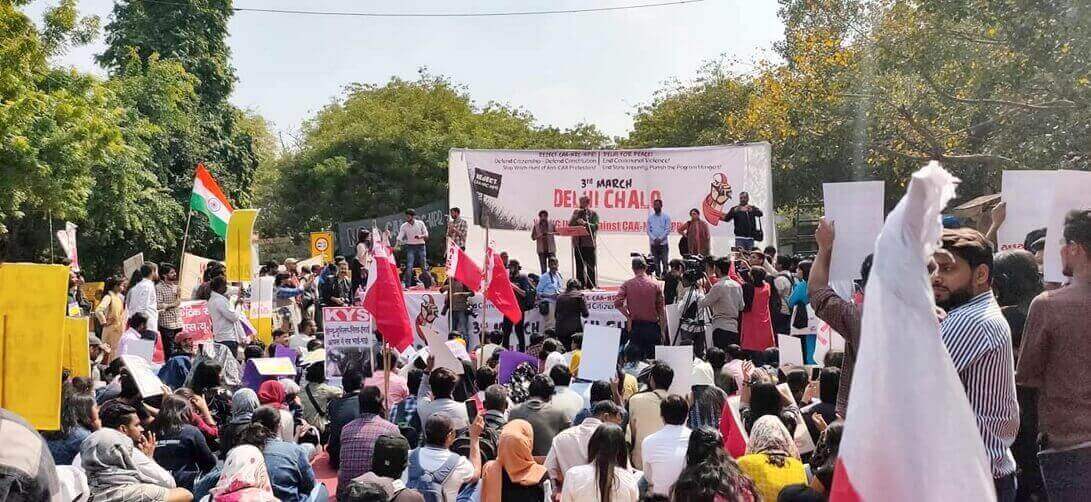
Following the pogrom in Delhi, which was clearly a calculated move to force the protesters into submission, our party and mass platforms took various initiatives according to the demands of the situation, as reported elsewhere in this issue. Special mention must be made of Young India – a coordination committee of over hundred student and youth organisations – which held peace marches, organised relief work and peace Committees and at the same time carried forward the movement through a month-long campaign culminating in the Delhi Chalo rally on March 3.

By the middle of March, the rapidly spreading Corona infection became the single most important concern for the whole nation, pushing all other issues behind. Physical distancing and avoiding large gatherings became absolutely imperative. In the larger interests of society, protesters at Washermenpet (Chennai) temporarily suspended the sit-in from 18 March and declared their resolve to resume the same as and when the situation permitted. On 21 March civil society group United Against Hate urged people in Delhi to hold up placards against CAA-NRC-NPR from balconies, windows and gates during the so-called 'Janta Curfew' and raise slogans at 5 pm. On 22 March, Shaheen Bagh (Delhi) adopted an innovative form of protest. Only five ladies sat on the protest site with sufficient distance between themselves, and put out the footwear of other protesters as a symbol of their presence. In Bihar, Shaheen Bagh activists themselves became fully involved in fighting the deadly pandemic.
Today the drastically changed situation demands that the movement against the Sanghi citizenship project be pursued as an integral part of the wider anti-fascist pro-democracy movement. It needs to be linked up, in a phased manner, with other pressing issues such as fighting the Corona menace and the gross inadequacy of official response, the exacerbated banking crisis in the wake of the Yes Bank episode, and so on. The battle will be long and hard, but in the end victory will be ours.
Liberation Archive
- 2001-2010
-
2011-2020
- 2011
- 2012
- 2013
- 2014
- 2015
- 2016
- 2017
- 2018
- 2019
-
2020
- Liberation, JANUARY 2020
- Liberation, FEBRUARY 2020
- Liberation, MARCH 2020
-
Liberation, APRIL 2020
- Modi's Response To The Coronavirus Pandemic Is Making The Crisis Much Worse
- What The Pandemic Teaches Us
- China and The Coronavirus Pandemic: Lessons for Communists
- Capitalist Agriculture and Covid-19: A Deadly Combination
- 1984 to 2020: A Tale of Shared Loss and Injustice
- 'This Is Our Version of the Coronavirus. We Are Sick'
- IWD 2020: International Women's Day And the Shaheen Bagh Revolution
- The Countrywide Upsurge against CAA-NRC-NPR: What We have achieved and What Comes Next
- Ranjan Gogoi: CJI Yesterday, Partisan Politician Today
- Tamil Nadu Round Up
- North East Delhi Struggles To Recover and Heal
- Surveillance State and the 'New Frontiers' of Power
- Dr Shyam Bihari Rai
- Liberation, MAY-JUNE 2020
- Liberation, JULY 2020
- Liberation, AUGUST 2020
- Liberation, SEPTEMBER 2020
- Liberation, OCTOBER 2020
- Liberation, NOVEMBER 2020
- Liberation, DECEMBER 2020
- 2021-2030
Charu Bhawan, U-90, Shakarpur, Delhi 110092
Phone: +91-11-42785864 | Fax:+91-11-42785864 | +91 9717274961
E-mail: info@cpiml.org




